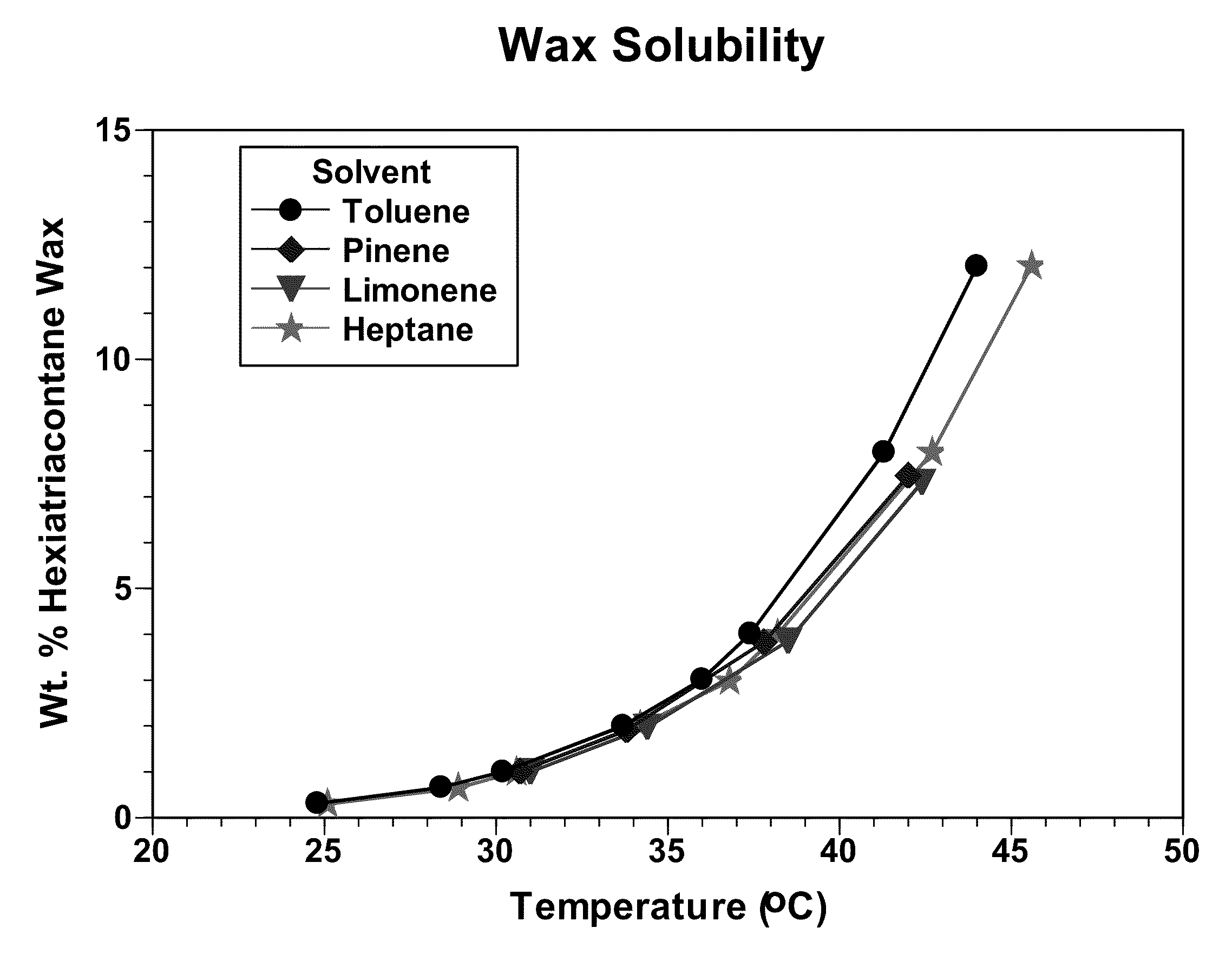Heat generation process for treating oilfield deposits
a technology for oilfield deposits and heat generation processes, which is applied in the direction of clayware, other domestic objects, and wellbore/well accessories, etc., can solve the problems of slow eat away at the surface of deposits, obstruct the flow of hydrocarbon production fluids, and not fast enough at most realistic surface-to-volume ratios, etc., to increase deposit solvency and temperature
- Summary
- Abstract
- Description
- Claims
- Application Information
AI Technical Summary
Benefits of technology
Problems solved by technology
Method used
Image
Examples
example # 1
Example #1
[0024]Dodecyl benzene sulfonic acid (DDBSA) was mixed into d-limonene from Florida Chemicals at room temperature: 23° C. The chemicals were mixed in a glass cylinder. The glass cylinder contained a stirring bar assembly and a thermocouple placed above the stirrer.
[0025]10.0 g d-limonene was introduced first and the DDBSA was added stepwise. A total of about 6 ml (6.05 g) was added during the course of the experiment, which lasted 6 minutes.
[0026]Result: an exotherm was generated heating the mixture to about 182° C. after the addition of 2-3 ml DDBSA. The addition of the last 2-3 ml did not seem to generate additional heat.
[0027]The reaction product was dark colored with a significant higher viscosity than limonene. The reaction product viscosity was 1349 cP at 25° C. It should be noted, dodecyl benzene sulfonic acid is a dark-colored viscous liquid and limonene is a clear-colored low viscosity liquid (about 1 cP viscosity at 25° C.).
example # 2
Example #2
[0028]DDBSA was mixed into d-limonene at room temperature: 23° C. The chemicals were mixed in a glass cylinder. The glass cylinder contained a stirring bar assembly and a thermocouple placed above the stirrer.
[0029]40.01 g d-limonene was introduced first and the DDBSA was added stepwise. A total of about 7 ml (7.04 g) was added during course of the experiment, which lasted 6 minutes.
[0030]Result: an exotherm was generated heating the mixture to about 196° C. after 5 minutes, with addition of the DDBSA at about 1 ml every minute.
[0031]The reaction product was dark colored with a significant higher viscosity than limonene. The reaction product viscosity was 563 cP at 25° C.
example # 3
Example #3
[0032]Dodecyl benzene sulfonic acid was mixed into myrcene at room temperature: 23° C. The chemicals were mixed in a glass cylinder. The glass cylinder contained a stirring bar assembly and a thermocouple placed above the stirrer.
[0033]20.01 g myrcene was introduced first and the DDBSA was added stepwise. A total of about 5 ml (4.79 g) was added during the course of the experiment, which lasted 6.5 minutes.
[0034]Result: an exotherm was generated heating the mixture to about 245° C. after addition of about 1 ml of DDBSA. Addition of the last 3 ml did not seem to generate additional heat.
[0035]The reaction product was a dark colored, relatively high viscosity liquid. The reaction product viscosity was not measured but was not too dissimilar to that of high viscosity myrcene.
PUM
| Property | Measurement | Unit |
|---|---|---|
| temperature | aaaaa | aaaaa |
| temperature | aaaaa | aaaaa |
| temperature | aaaaa | aaaaa |
Abstract
Description
Claims
Application Information
 Login to View More
Login to View More - R&D
- Intellectual Property
- Life Sciences
- Materials
- Tech Scout
- Unparalleled Data Quality
- Higher Quality Content
- 60% Fewer Hallucinations
Browse by: Latest US Patents, China's latest patents, Technical Efficacy Thesaurus, Application Domain, Technology Topic, Popular Technical Reports.
© 2025 PatSnap. All rights reserved.Legal|Privacy policy|Modern Slavery Act Transparency Statement|Sitemap|About US| Contact US: help@patsnap.com


